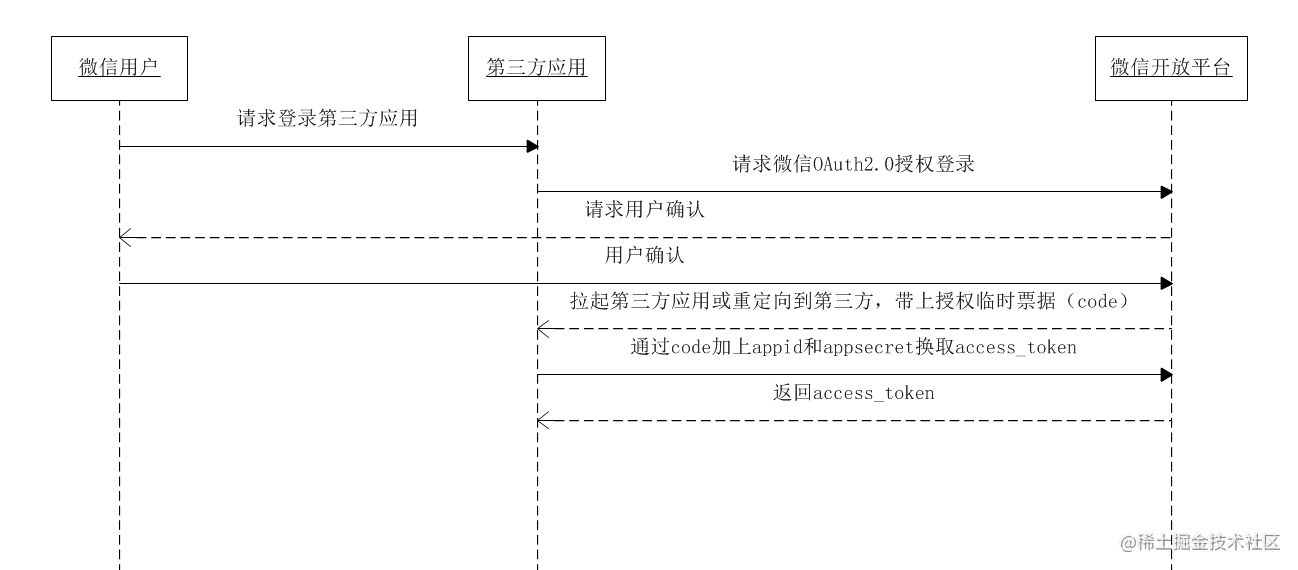本文首发于掘金 https://juejin.cn/post/7185009884646080567
前言
难易程度: 简单
背景
最近在写闪调想接第三方授权登陆,比如微信的扫码登陆。 qq、github、钉钉等授权登陆, 大家肯定在第三方网站用过其中之一。
它是基于OAuth2.0协议标准设计的,接过一家的,你会发现其他家的都一样。
理清逻辑
我们拿微信的的整体流程举例。
1. 第三方发起微信授权登录请求,微信用户允许授权第三方应用后,微信会拉起应用或重定向到第三方网站,并且带上授权临时票据 code 参数;
2. 通过 code 参数加上 AppID 和AppSecret等,通过 API 换取access_token;
3. 通过access_token进行接口调用,获取用户基本数据资源或帮助用户实现基本操作。
上一张官方图

1、跳转到第三方授权页面。
首先得得让用户点击之后跳到一个去操作授权的页面, 或者内嵌。
比如这个

这个

2、用户授权, 带着authCode回调咱们后端接口
3、 authCode换取token, token获取用户信息, 定向首页。
这一步后端写个接口, 用authCode换取token, token再获取用户信息,
然后处理自己的业务逻辑,重定向到首页,至此,登陆完成。
示例地址
http://st.mawenqing.net/api/user/login
代码实现
我们以nodejs的midwayjs框架为例
midwayjs是阿里开源的面相未来的nodejs框架
midway官网 http://www.midwayjs.org/
第三方授权用的钉钉, 本来想用微信,后来发现微信开放平台个人不好注册。
1、定向到授权页面
调登陆接口, 后端重定向到钉钉授权页面
于是需要一个后端的重定向的接口, 如下
import {Inject, Controller, Get, Query} from '@midwayjs/decorator';
import {Context} from '@midwayjs/koa';
import {UserService} from '../service/user.service';
import {AliYunService} from '../service/aliyun.service';
import BaseController from "../core/baseController";
@Controller('/api/user')
export class UserController extends BaseController {
@Inject()
ctx: Context;
@Inject()
userService: UserService;
@Get('/login')
async login() {
const url = this.userService.dingTalkLogin();
this.ctx.redirect(url)
}
}
2、用户操作后、带着code回调, 处理逻辑。
带着code回调咱们,其实是一个重定向, 可以看做get请求。
于是写一个接口, 来处理回调请求
- a、用code获取AccessToken
- b、AccessToken换取用户信息
- c、后面就处理业务逻辑了,示例比如 判断用户是否存在, 存在就登陆,不存在,注册,并登陆,最后重定向到首页。
/**
* 用户授权回调
* @param authCode
*/
@Get('/auth')
async auth(@Query('authCode') authCode) {
// a、用code获取AccessToken
const result = await this.userService.userAccessToken(authCode);
if (!result.accessToken) {
return this.fail()
}
// b、AccessToken换取用户信息
const userInfo = await this.userService.getUserInfo(result.accessToken)
// c、后面就处理业务逻辑了,示例比如 判断用户是否存在, 存在就登陆,不存在,注册,并登陆,最后重定向到首页。
// 判断用户是否存在
let user: any = await this.userService.findUser({openId: userInfo.openId})
if (!user) {
user = {
openId: userInfo.openId,
avatarUrl: userInfo.avatarUrl,
userName: userInfo.nick,
mobile: userInfo.mobile,
createTime: new Date()
}
// 不存在注册存库
await this.userService.saveUser(user)
}
// 设置cookies, 这样就登陆了 伪代码
this.ctx.cookies.set('st_user', JSON.stringify(user), {
path: '/', // 写cookie所在的路径
maxAge: 10 * 60 * 1000, // cookie有效时长
// expires: new Date('2017-02-15'), // cookie失效时间
httpOnly: true, // 是否只用于http请求中获取
overwrite: false, // 是否允许重写
encrypt: true, // 加密传输
});
// 重定向到首页
this.ctx.redirect('/')
}
github代码链接
https://github.com/girl-email/st-server-nodejs/blob/feature-1.0/src/controller/user.controller.ts
总结
通过以上, 我们了解了第三方授权登陆的基本流程, 并且实现了钉钉第三方网站授权登陆, 今天就到这了,希望对你有所帮助,我们下期见。






















 3588
3588











 被折叠的 条评论
为什么被折叠?
被折叠的 条评论
为什么被折叠?








